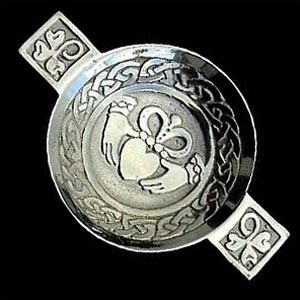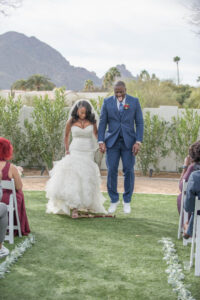
Weddings are a universal celebration of love, but the way they are celebrated can vary widely across different cultures. From vibrant ceremonies to deeply symbolic rituals, each tradition brings its own unique charm to the wedding day. In this blog post, we’ll explore 2-4 cultural wedding traditions from African, American, Chinese, Dutch, Hindu, Irish, Italian, Jewish, Mexican and Scandinavian cultures. Incorporating these traditions can add depth, meaning, and a touch of global flair to your special day.
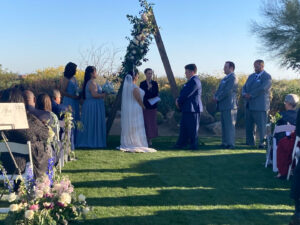
American Wedding Traditions
- The White Wedding Dress The tradition of the bride wearing a white wedding dress symbolizes purity and has become an iconic part of American weddings. This trend began with Queen Victoria’s wedding in 1840 and continues to be a staple in modern ceremonies.
- The Bridal Party Bridesmaids and groomsmen are an essential part of American weddings. They not only support the couple throughout the planning process but also stand by their side during the ceremony, signifying the importance of friendship and community in the marriage.
- The First Dance The couple’s first dance is a cherished moment at American wedding receptions. The newlyweds choose a meaningful song and share their first dance as a married couple, often setting the tone for the evening’s celebrations.
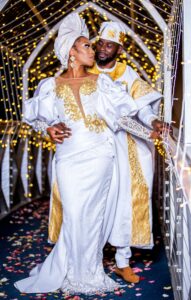
African Wedding Traditions
- The Libation Ceremony In many African cultures, the Libation Ceremony involves offering prayers and pouring water or wine onto the ground to honor ancestors and seek their blessings for the marriage. This tradition connects the couple to their heritage and emphasizes the importance of family and community in the marriage.
- The Kola Nut Ceremony The Kola Nut Ceremony is a significant tradition in West African weddings, where the kola nut is broken and shared among the guests. This act symbolizes unity, healing, and the couple’s commitment to each other. The kola nut is often accompanied by blessings and well-wishes from the elders.
- Jumping the Broom Jumping the broom is a tradition that originated in West Africa and is now popular in African American weddings. The couple jumps over a broomstick together, symbolizing the sweeping away of the past and the beginning of a new life. This ritual represents the couple’s commitment to building a home together.
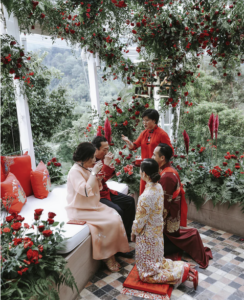
Chinese Wedding Traditions
- The Tea Ceremony The tea ceremony is a vital part of Chinese weddings, where the bride and groom serve tea to their parents and elders as a sign of respect and gratitude. In return, the couple receives blessings and gifts, usually in the form of red envelopes containing money. This tradition emphasizes the importance of family and filial piety.
- Red Symbolism Red is a dominant color in Chinese weddings, symbolizing joy, luck, and prosperity. The bride often wears a red dress, and the wedding decorations, including the invitations and the banquet, feature red elements. Incorporating red into your wedding can bring good fortune and happiness to your marriage.
- Hair Combing Ceremony The hair combing ceremony is a traditional ritual that takes place the night before the wedding. The bride’s mother combs her hair four times, each stroke representing a different blessing: a harmonious marriage, a happy family, good health, and longevity. This ritual marks the bride’s transition from childhood to adulthood.
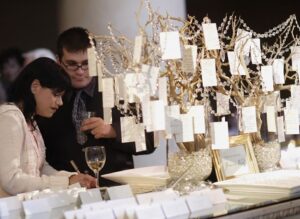
Dutch Wedding Traditions
- The Bridal Wagon In the Netherlands, it’s traditional for the bride and groom to arrive at the wedding ceremony in a bridal wagon or horse-drawn carriage. This grand entrance symbolizes the importance of the occasion and adds an element of old-world charm to the wedding day.
- Tree Planting Ceremony A beautiful Dutch tradition involves the couple planting a tree together during their wedding ceremony. This tree symbolizes the growth of their love and their commitment to nurturing their marriage over time. The couple often revisits the tree on anniversaries to see how it has grown, much like their relationship.
- The Wishing Tree At Dutch weddings, guests write down their wishes for the couple on small pieces of paper or cards, which are then hung on a tree at the reception. This tradition allows guests to share their hopes and blessings for the couple’s future in a personal and meaningful way.
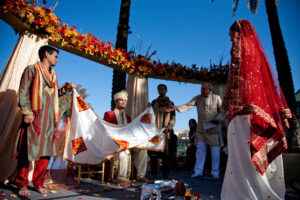
Hindu Wedding Traditions
- The Saptapadi (Seven Steps) One of the most important rituals in a Hindu wedding is the Saptapadi, where the bride and groom take seven steps around a sacred fire, known as the Agni. With each step, they make a vow to support and cherish each other throughout their marriage. This ritual symbolizes their commitment to a life of mutual respect, understanding, and togetherness.
- The Mehendi Ceremony Before the wedding, the bride’s hands and feet are adorned with intricate henna designs during the Mehendi ceremony. The beautiful patterns are believed to bring good luck and symbolize joy, beauty, and spiritual awakening. The darker the henna, the stronger the bond between the couple is believed to be.
- The Mangalsutra The groom ties a sacred necklace, known as the Mangalsutra, around the bride’s neck during the wedding ceremony. This necklace symbolizes the bride’s new status as a married woman and is a sign of love, respect, and commitment. The Mangalsutra is a cherished piece of jewelry that the bride wears throughout her married life.
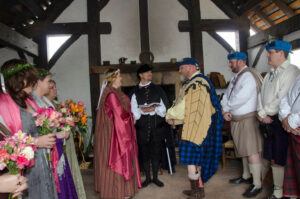
Irish Wedding Traditions
- The Claddagh Ring The Claddagh ring, a traditional Irish symbol of love, loyalty, and friendship, is often used in Irish weddings. The ring features two hands holding a heart, topped with a crown. How the ring is worn can indicate the wearer’s relationship status, making it a meaningful part of the wedding ceremony.
- The Handfasting Ceremony The Handfasting ceremony is an ancient Celtic tradition where the couple’s hands are bound together with a ribbon or cord, symbolizing their union. This ritual is where the phrase “tying the knot” originates and is a beautiful way to represent the couple’s commitment to each other.
- Irish Wedding Blessing An Irish wedding wouldn’t be complete without the famous Irish wedding blessing. This blessing is a heartfelt prayer for the couple’s future, often recited during the ceremony. It reflects the deep spirituality and cultural heritage of the Irish people.
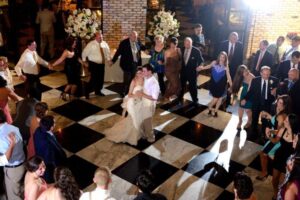
Italian Wedding Traditions
- La Serenata (Serenade) The night before the wedding, the groom traditionally serenades the bride beneath her window, accompanied by musicians, friends, and family. This romantic gesture is a declaration of love and devotion, setting a joyful and celebratory tone for the wedding day.
- Confetti and Sugared Almonds In Italian weddings, confetti refers to sugar-coated almonds, which are given to guests as favors. These almonds are usually presented in odd numbers, symbolizing health, wealth, happiness, fertility, and longevity. The tradition of giving confetti is a way to wish the couple good fortune and thank guests for their presence.
- The Tarantella Dance The Tarantella is a lively folk dance performed at Italian wedding receptions. Guests form a circle around the couple, clapping and dancing in a fast-paced rhythm. This dance is a symbol of joy and celebration, ensuring that the reception is filled with energy and fun.
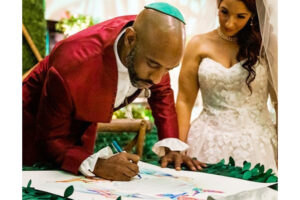
Jewish Wedding Traditions
- The Chuppah (Wedding Canopy) The Chuppah is a central element in a Jewish wedding ceremony, symbolizing the home the couple will build together. The open sides represent hospitality and the couple's commitment to welcoming others into their lives. The Chuppah is often held by friends or family members, emphasizing the support of the community.
- The Ketubah (Marriage Contract) The Ketubah is a beautifully decorated marriage contract that outlines the couple’s responsibilities to each other. It is signed by the couple and witnesses before the ceremony and is often displayed in their home as a reminder of their vows. The Ketubah is a symbol of love, commitment, and the sanctity of marriage.
- The Breaking of the Glass At the end of the Jewish wedding ceremony, the groom (and sometimes the bride) breaks a glass underfoot, symbolizing the fragility of relationships and the importance of cherishing each other. This tradition also serves as a reminder of the destruction of the Temple in Jerusalem. The guests then shout “Mazel Tov!” to celebrate the couple’s union.
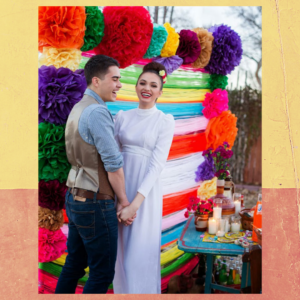
Mexican Wedding Traditions
- The Lazo Ceremony The Lazo ceremony involves placing a lasso or large rosary around the couple’s shoulders in the shape of a figure eight, symbolizing their eternal bond. This tradition is a beautiful representation of the couple’s unity and their commitment to each other.
- The Arras (Thirteen Gold Coins) The groom presents the bride with thirteen gold coins, known as Arras, representing Jesus and the twelve apostles. This act symbolizes the groom’s promise to support his bride and their future family. The bride accepts the coins, signifying her trust and faith in her husband.
- Mariachi Music Mexican weddings are known for their lively celebrations, often featuring Mariachi music. A Mariachi band plays traditional Mexican songs during the ceremony and reception, creating a festive and joyous atmosphere. The music is an essential part of the celebration, reflecting the couple’s cultural heritage.
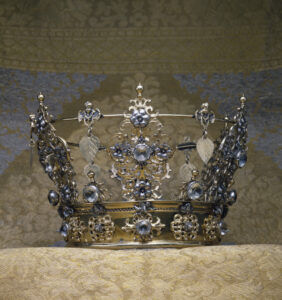
Scandinavian Wedding Traditions
- The Bridal Crown In Scandinavian weddings, the bride may wear a silver or gold crown adorned with tiny charms or bells. The crown represents purity and the bride’s new status as a married woman. The bells are believed to ward off evil spirits and protect the bride on her wedding day.
- The Kransekake The Kransekake is a traditional Scandinavian wedding cake made of concentric rings of almond dough stacked in a conical shape. The cake is decorated with icing and flags, and the couple removes the top ring together, symbolizing their shared future and prosperity.
- Kissing Rituals In Denmark, guests have a playful tradition of stealing kisses from the bride or groom when the other leaves the room. This adds a fun and light-hearted element to the reception, reflecting the joy and love shared by the couple and their guests.
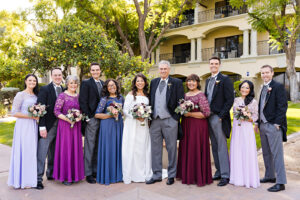
Bringing Global Traditions into Your Wedding
Incorporating cultural traditions into your wedding is a beautiful way to honor your heritage, create lasting memories, and add unique elements to your celebration. Whether you choose to include a few symbolic rituals or fully embrace a specific culture’s customs,making it a day to remember for the couple and their guests.
Ready to plan a wedding that reflects your unique cultural heritage? Contact us today to start incorporating these beautiful traditions into your celebration. If there's a tradition not mentioned in this article that you'd love to include in your special day, MJK Events can and will seamlessly incorporate it into your celebration. Let’s create a wedding that’s as meaningful as it is memorable!


